Rocket: Difference between revisions
rev. edits back to original |
No edit summary |
||
| Line 5: | Line 5: | ||
Rockets are used for [[fireworks]], weaponry, launching artificial [[satellites]], [[human spaceflight]] and [[Space exploration | exploring]] other planets. While they are inefficient for low speed, they can reach extremely high speeds when staging is employed. |
Rockets are used for [[fireworks]], weaponry, launching artificial [[satellites]], [[human spaceflight]] and [[Space exploration | exploring]] other planets. While they are inefficient for low speed, they can reach extremely high speeds when staging is employed. |
||
Rockets have a long and distinguished history going back almost 1000 years that includes manned landings on the moon; and in the 21st century has enabled commercial [[space tourism]]. |
Rockets have a long and distinguished history going back almost 1000 years that includes manned landings on the moon; and in the 21st century has enabled commercial [[space tourism]]. In FF7, Cid flew a rocket but his girlfriend fucked it up. |
||
== Overview == |
== Overview == |
||
Revision as of 10:28, 12 March 2007

A rocket is a vehicle, missile or aircraft which obtains thrust by the reaction to the ejection of fast moving fluid from within a rocket engine.
Rockets are used for fireworks, weaponry, launching artificial satellites, human spaceflight and exploring other planets. While they are inefficient for low speed, they can reach extremely high speeds when staging is employed.
Rockets have a long and distinguished history going back almost 1000 years that includes manned landings on the moon; and in the 21st century has enabled commercial space tourism. In FF7, Cid flew a rocket but his girlfriend fucked it up.
Overview
Uses
Military
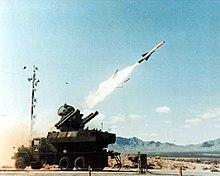
In a military application, a rocket serves as the means by which a payload is delivered to a target. Together, a rocket and a payload are generally referred to as a missile. Payloads delivered on a ballistic trajectory are often identified as warheads, and payloads delivered on an orbital trajectories such as satellites including spy satellites. Rocket engines provide the initial energy for such trajectories; unlike air breathing aircraft the burn time can be much shorter than the flight time which can be of an indefinite length. A third kind of trajectory that uses a rocket engine is a powered trajectory. An example of this is a short-range guided missile designed to fly to target under power.
During the Vietnam era, there were also air-launched unguided rockets that carried a nuclear payload designed to attack aircraft formations in flight. In military terminology, the word missile is often preferred over rocket when the weapon uses either solid or liquid propellant, and has a guidance system. (This distinction generally does not apply to civilian or orbital launch vehicles.)
Civil
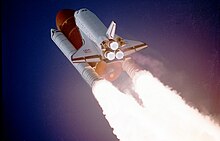
Rockets remain the only way to leave the Earth gravitational field and are used to launch a payload into orbit, to rapidly accelerate vehicles, to change orbits, to de-orbit for landing, or to decelerate a vehicle for landing in an environment where there is no atmosphere, e.g., the Moon, comets, asteroids. Also, a rocket may be used to soften a hard parachute landing immediately before touchdown (see Soyuz spacecraft).
Operation
In all rockets, the exhaust is formed from propellant, which is carried within the rocket prior to its release. Rocket thrust is due to the action of accelerating the exhaust to very high speeds causing an equal and opposite reaction on the vehicle.
Types
There are many different types of rockets, and a comprehensive list can be found in rocket engine — they range in size from tiny models such as water rockets or small solid rockets that can be purchased at a hobby store, to the enormous Saturn V used for the Apollo program.
Most current rockets are chemically powered rockets (internal combustion engines) that emit a hot exhaust gas. A chemical rocket engine can use solid propellant (see Space Shuttle's SRBs), liquid propellant (see Space shuttle main engine), or a hybrid mixture of both. A chemical reaction is initiated between the fuel and the oxidizer in the combustion chamber, and the resultant hot gases accelerate out of a nozzle (or nozzles) at the rearward-facing end of the rocket. The acceleration of these gases through the engine exerts force ("thrust") on the combustion chamber and nozzle, propelling the vehicle (in accordance with Newton's Third Law). See rocket engine for details.
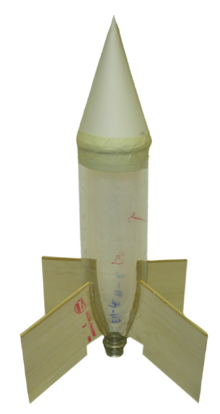
Not all rockets use chemical reactions. Steam rockets, for example, release superheated water through a nozzle where it instantly flashes to high velocity steam, propelling the rocket. The efficiency of steam as a rocket propellant is relatively low, but it is simple and reasonably safe, and the propellant is cheap and widely available. Most steam rockets have been used for propelling land-based vehicles but a small steam rocket was tested in 2004 on board the UK-DMC satellite. There are even proposals to use steam rockets for interplanetary transport using either nuclear or solar heating as the power source to vaporize water collected from around the solar system.[1]
Rockets where the heat is supplied from other than the propellant, such as steam rockets, are classed as external combustion engines. Other examples of external combustion rocket engines include most designs for nuclear powered rocket engines. Use of hydrogen as the propellant for external combustion engines gives very high velocities.
Rockets must be used when there is no other substance (land, water, or air) or force (gravity, magnetism, light) that a vehicle may employ for propulsion, such as in space. In these circumstances, it is necessary to carry all the propellant to be used.
Delta-v
Delta-v is the theoretical total change in velocity that a rocket can achieve without any external interference (without air drag or gravity or other forces).
Due to their high exhaust velocity (Mach ~10+), rockets are particularly useful when very high speeds are required, such as orbital speed (Mach 25+). The speeds that a rocket vehicle can reach can be calculated by the Tsiolkovsky rocket equation, which gives the speed difference ("delta-v") in terms of the exhaust speed and ratio of initial mass to final mass ("mass ratio").

Propulsive efficiency
With rockets it is often important that as much of the energy stored in the propellant ends up as kinetic energy of the body of the rocket as possible, with as little as possible wasted in the exhaust jet.
In common with many jet-based engines, but particularly in rockets due to their high and typically fixed exhaust speed, rockets are extremely inefficient at low speeds. There, the exhaust carries away a huge amount of kinetic energy rearward. As speeds rise the resultant exhaust speed goes down, and thus energetic efficiency rises, reaching a peak of (theoretically) 100% when the vehicle is traveling exactly at the same speed that the exhaust is emitted; and then the exhaust in principle stops dead in space behind the vehicle. The efficiency then drops off again at even higher speeds as the exhaust ends up traveling forwards behind the vehicle.[4] These energy considerations mean that rockets are mainly useful when a very high speed is required, and thus they are rarely if ever used for general aviation. Jet engines which have a better match between speed and exhaust velocity such as turbofans predominate for atmospheric use.
Staging
The mass ratios that can be achieved with a single set of fixed rocket engines and tankage varies depends on acceleration required, construction materials, tank layout, engine type and propellants used, but for example the first stage of the Saturn V was able to achieve about a mass ratio of 10.
Often, the required velocity (delta-v) for a mission is unattainable by any single rocket because the propellant, structure, guidance and engines weigh so much as to prevent the mass ratio from being high enough.

This problem is frequently solved by staging — the rocket sheds excess weight (usually tankage and engines) during launch to reduce its weight and effectively increase its mass ratio.
Typically, the acceleration of a rocket increases with time (if the thrust stays the same) as the weight of the rocket decreases as propellant is burned. Discontinuities in acceleration will occur when stages burn out, often starting at a lower acceleration with each new stage firing.
Vehicles
Rockets as a group have the highest thrust-to-weight ratio of any type of engine; and this helps vehicles achieve a high mass ratios, which improves the performance of flight.
Common mass ratios for vehicles are 20:1 for dense propellants such as liquid oxygen and kerosene, 25:1 for dense monopropellants such as hydrogen peroxide, and 10:1 for liquid oxygen and liquid hydrogen. However, mass ratio is highly dependent on many factors such as the type of engine the vehicle uses and structural safety margins.
History of Rockets
Origins of rocketry

The origin of rockets as most people think of them dates back over 2,000 years ago when people of the Han Dynasty in China (206 BC – 220 AD) began experimenting with gunpowder and fireworks. The explosive force of such pyrotechnics were eventually adapted for use in propelling projectiles such as cannon, musket balls and fire arrows. Without pyrotechnics, modern aviation and spaceflight would be impracticable; this is because pyrotechnic devices combine high reliability with very compact and efficient energy storage: essentially in the form of latent hot gases or as a shock wave as in bolt and cable cutters. Such projectiles do not contain their own fuel, and thus do not meet the definition of a rocket. Therefore the use of gunpowder to propel projectiles is a precursor to the development of the first solid rocket.
According to the writings of the Roman Aulus Gellius, in c. 400 BC, a Greek Pythagorean named Archytas, propelled a wooden bird along wires using steam. However, those rockets do not appear to have been powerful enough for taking off under its own thrust. The ancient Chinese invention of gunpowder by Taoist alchemists with special circles, and their use of it in various forms of weapons like fire arrows, bombs, and cannons resulted in the development of the rocket.
Spread of rocket technology

Rocket technology first became known to Europeans following their use by the Mongols Genghis Khan and Ögedei Khan when they conquered parts of Russia, Eastern, and Central Europe. The Mongolians had stolen the Chinese technology by conquest of the northern part of China and also by the subsequent employment of Chinese rocketry experts as mercenaries for the Mongol military. Reports of the Battle of Sejo in the year 1241 describe the use of rocket-like weapons by the Mongols against the Magyars.[5]
Additionally, the spread of rockets into Europe was also influenced by the Ottomans at the siege of Constantinople in 1453, although it is very likely that the Ottomans themselves were influenced by the Mongol invasions of the previous few centuries. They appear in literature describing the capture of Baghdad in 1258 by the Mongols.[5]
In their history of rockets published on the internet NASA says “the Arabs adopted the rocket into their own arms inventory and, during the Seventh Crusade, used them against the French Army of King Louis IX in 1268.".[6]
The name Rocket comes from the italian Rocchetta (i.e. reel, or fuse), a name of a small firecracker created by the Italian artificer Muratori in 1379.[7]
For over two centuries, the work of Polish-Lithuanian Commonwealth nobleman Kazimierz Siemienowicz, "Artis Magnae Artilleriae pars prima" ("Great Art of Artillery, the First Part". also known as "The Complete Art of Artillery"), was used in Europe as a basic artillery manual. The book provided the standard designs for creating rockets, fireballs, and other pyrotechnic devices. It contained a large chapter on caliber, construction, production and properties of rockets (for both military and civil purposes), including multi-stage rockets, batteries of rockets, and rockets with delta wing stabilizers (instead of the common guiding rods).
At the end of the 18th century, iron-cased rockets were successfully used militarily in India against the British by Tipu Sultan of the Kingdom of Mysore during the Anglo-Mysore Wars. The British then took an active interest in the technology and developed it further during the 19th century. The major figure in the field at this time was William Congreve. From there, the use of military rockets spread throughout Europe. At the Battle of Baltimore in 1814, the rockets fired on Fort McHenry by the rocket vessel HMS Erebus were the source of the rockets' red glare described by Francis Scott Key in The Star-Spangled Banner. Rockets were also used in the Battle of Waterloo.

Early rockets were very inaccurate. Without the use of spinning or any gimballing of the thrust, they had a strong tendency to veer sharply off course. The early British Congreve rockets reduced this somewhat by attaching a long stick to the end of a rocket (similar to modern bottle rockets) to make it harder for the rocket to change course. The largest of the Congreve rockets was the 32-pound (14.5 kg) Carcass, which had a 15-foot (4.6 m) stick. Originally, sticks were mounted on the side, but this was later changed to mounting in the center of the rocket, reducing drag and enabling the rocket to be more accurately fired from a segment of pipe.
In 1815, Alexander Zasyadko began his work on creating military gunpowder rockets. He constructed rocket-launching platforms, which allowed to fire in salvos (6 rockets at a time), and gun-laying devices. Zasyadko elaborated a tactics for military use of rocket weaponry. In 1820, Zasyadko was appointed head of the Petersburg Armory, Okhtensky Powder Factory, pyrotechnic laboratory and the first Highest Artillery School in Russia. He organized rocket production in a special rocket workshop and created the first rocket sub-unit in the Russian army.
The accuracy problem was mostly solved in 1844 when William Hale modified the rocket design so that thrust was slightly vectored to cause the rocket to spin along its axis of travel like a bullet. The Hale rocket removed the need for a rocket stick, travelled further due to reduced air resistance, and was far more accurate.
In 1903, high school mathematics teacher Konstantin Tsiolkovsky (1857-1935) published Исследование мировых пространств реактивными приборами (The Exploration of Cosmic Space by Means of Reaction Devices), the first serious scientific work on space travel. The Tsiolkovsky rocket equation—the principle that governs rocket propulsion—is named in his honor (although it had been discovered previously[8]). His work was essentially unknown outside the Soviet Union, where it inspired further research, experimentation, and the formation of the Cosmonautics Society. His work was republished in the 1920s in response to Russian interest in the work of Robert Goddard. Among other ideas, Tsiolkovsky accurately proposed to use liquid oxygen and liquid hydrogen as a nearly optimal propellant pair and determined that building staged and clustered rockets to increase the overall mass efficiency would dramatically increase range.
Modern rocketry
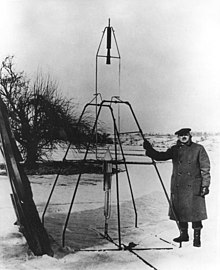
Modern rockets were born when Robert Goddard attached a supersonic (de Laval) nozzle to a liquid fuelled rocket engine's combustion chamber. These nozzles turn the hot gas from the combustion chamber into a cooler, hypersonic, highly directed jet of gas; more than doubling the thrust and enormously raising the efficiency. Early rockets had been grossly inefficient because of the heat energy that was wasted in the exhaust gases. In 1920, Goddard published A Method of Reaching Extreme Altitudes, the first serious work on using rockets in space travel after Tsiolkovsky. The work attracted worldwide attention and was both praised and ridiculed, particularly because of its suggestion that a rocket theoretically could reach the Moon. A New York Times editorial famously even accused Goddard of fraud, by incorrectly implying that he knew that rockets would not work in space.
In 1923, Hermann Oberth (1894-1989) published Die Rakete zu den Planetenräumen ("The Rocket into Planetary Space"), a version of his doctoral thesis, after the University of Munich rejected it.
In 1926, Robert Goddard launched the world's first liquid-fueled rocket in Auburn, Massachusetts.
During the 1920s, a number of rocket research organizations appeared in America, Austria, Britain, Czechoslovakia, France, Italy, Germany, and Russia. In the mid-1920s, German scientists had begun experimenting with rockets which used liquid propellants capable of reaching relatively high altitudes and distances. A team of amateur rocket engineers had formed the Verein für Raumschiffahrt (German Rocket Society, or VfR) in 1927, and in 1931 launched a liquid propellant rocket (using oxygen and gasoline).
From 1931 to 1937, the most extensive scientific work on rocket engine design occurred in Leningrad, at the Gas Dynamics Laboratory. Well funded and staffed, over 100 experimental engines were built under the direction of Valentin Glushko. The work included regenerative cooling, hypergolic ignition, and fuel injector designs that included swirling and bi-propellant mixing injectors. However, the work was curtailed by Glushko's arrest during Stalinist purges in 1938. Similar but much less extensive work was also done by the Austrian professor Eugen Sänger.
In 1932, the Reichswehr (which in 1935 became the Wehrmacht) began to take an interest in rocketry. Artillery restrictions imposed by the Treaty of Versailles limited Germany's access to long distance weaponry. Seeing the possibility of using rockets as long-range artillery fire, the Wehrmacht initially funded the VfR team, but seeing that their focus was strictly scientific, created its own research team, with Hermann Oberth as a senior member. At the behest of military leaders, Wernher von Braun, at the time a young aspiring rocket scientist, joined the military (followed by two former VfR members) and developed long-range weapons for use in World War II by Nazi Germany, notably the A-series of rockets, which led to the infamous V-2 rocket (initially called A4).
In 1943, production of the V-2 rocket began. The V-2 had an operational range of 300 km (185 miles) and carried a 1000 kg (2204 lb) warhead, with an amatol explosive charge. The vehicle was only different in details from most modern rockets, with turbopumps, inertial guidance and many other features. Thousands were fired at various Allied nations, mainly England, as well as Belgium and France. While they could not be intercepted, their guidance system design and single conventional warhead meant that the V-2 was insufficiently accurate against military targets. 2,754 people in England were killed, and 6,523 were wounded before the launch campaign was terminated. While the V-2 did not significantly affect the course of the war, it provided a lethal demonstration of the potential for guided rockets as weapons.

At the end of World War II, competing Russian, British, and U.S. military and scientific crews raced to capture technology and trained personnel from the German rocket program at Peenemünde. Russia and Britain had some success, but the United States benefited most. The US captured a large number of German rocket scientists (many of whom were members of the Nazi Party, including von Braun) and brought them to the United States as part of Operation Paperclip. There the same rockets that were designed to rain down on Britain were used instead by scientists as research vehicles for developing the new technology further. The V-2 evolved into the American Redstone rocket, used in the early space program.
After the war, rockets were used to study high-altitude conditions, by radio telemetry of temperature and pressure of the atmosphere, detection of cosmic rays, and further research. This continued in the U.S. under von Braun and the others, who were destined to become part of the U.S. scientific complex.
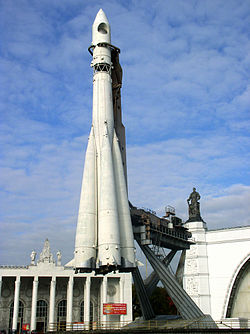
Independently, research continued in the Soviet Union under the leadership of Sergei Korolev. With the help of German technicians, the V-2 was duplicated and improved as the R-1, R-2 and R-5 missiles. German designs were abandoned in the late 1940s, and the foreign workers were sent home. A new series of engines built by Glushko and based on inventions of Aleksei Isaev formed the basis of the first ICBM, the R-7. The R-7 launched the first satellite, the first man into space and the first lunar and planetary probes, and is still in use today. These events attracted the attention of top politicians, along with more money for further research.
Rockets became extremely important militarily in the form of intercontinental ballistic missiles (ICBMs) when it was realised that nuclear weapons carried on a rocket vehicle were essentially not defensible against once launched, and they became the delivery platform of choice for these weapons.
Fueled partly by the Cold War, the 1960s became the decade of rapid development of rocket technology in the Soviet Union (Vostok, Soyuz, Proton) and in the United States (e.g. X-20 Dyna-Soar, Gemini), including research in other countries, such as Britain, Japan, Australia, etc. Culminating at the end of the 60s with the manned landing on the moon via the Saturn V, causing the New York Times to retract their earlier editorial implying that spaceflight couldn't work.
Current day
Rockets remain a popular military weapon. The use of large battlefield rockets of the V-2 type has given way to guided missiles. However rockets are often used by helicopters and light aircraft for ground attack, being more powerful than machine guns, but without the recoil of a heavy cannon. In the 1950s there was a brief vogue for air-to-air rockets, including the AIR-2 'Genie' nuclear rocket, but by the early 1960s these had largely been abandoned in favor of air-to-air missiles.
Economically, rocketry has enabled access to space and launched the era of satellite communication. Scientifically, rocketry has opened a window on our universe, allowing the launch of space probes to explore our solar system, satellites to monitor Earth itself, and telescopes to obtain a clearer view of the rest of the universe.

However, in the minds of much of the public, the most important use of rockets is manned spaceflight. Vehicles such as the Space Shuttle for scientific research, the Soyuz for orbital tourism and Spaceship One for suborbital tourism show the way towards greater commercialisation of rocketry, away from government funding, and towards more widespread access to space.
Net thrust
Below is an approximate equation for calculating the Gross Thrust of a rocket:
where:
exhaust gas mass flow
jet velocity at nozzle exit plane
flow area at nozzle exit plane
static pressure at nozzle exit plane
ambient (or atmospheric) pressure
Since, unlike a jet engine, a conventional rocket motor lacks an air intake, there is no Ram Drag to deduct from the Gross Thrust. Consequently the Net Thrust of a rocket motor is equal the Gross Thrust.
The term represents the momentum thrust, which remains constant at a given throttle setting, whereas the term represents the pressure thrust term. At full throttle, the net thrust of a rocket motor improves slightly with increasing altitude, because the reducing atmospheric pressure increases the pressure thrust term.
It is however very usual to rearrange the above equation slightly:
Where: the effective exhaust velocity in a vacuum of that particular engine.
Regulation
Under international law, the nationality of the owner of a launch vehicle determines which country is responsible for any damages resulting from that vehicle. Due to this, some countries require that rocket manufacturers and launchers adhere to specific regulations to indemnify and protect the safety of people and property that may be affected by a flight.
In the US any rocket launch that is not classified as amateur, and also is not "for and by the government," must be approved by the Federal Aviation Administration's Office of Commercial Space Transportation (FAA/AST), located in Washington, DC.
Accidents
Because of the enormous chemical energy in all useful rocket fuels (greater energy per weight ratio than explosives, but lower than gasoline), accidents can and have happened. The number of people injured or killed is usually small because of the great care typically taken, but this record is not perfect.
See Space disasters
References
- ^ Neofuel-new fuel: Near Earth Object fuel
- ^ table of cislunar/mars delta-vs
- ^ cislunar delta-vs
- ^ Rocket Propulsion elements- seventh edition, pg38
- ^ a b "NASA Spacelink - "A brief history of rocketry"". Retrieved 2006-08-19.
- ^ A Brief History of Rocketry
- ^ Von Braun, Wernher & Frederick I. Ordway, III. HISTORY OF ROCKETRY AND SPACE TRAVEL, 1966
- ^ Johnson W., "Contents and commentary on William Moore's a treatise on the motion of rockets and an essay on naval gunnery", International Journal of Impact Engineering, Volume 16, Number 3, June 1995, pp. 499-521
See also
Lists
- List of spaceflights
- Timeline of rocket and missile technology
- List of rockets
- Spacecraft propulsion - describes many different propulsion systems for spacecraft
General rocketry
- Bipropellant rocket - two-part liquid or gaseous fuelled rockets
- Tripropellant rocket - variable propellant mixes can improve performance
- Hot Water rocket - powered by boiling water
- Hybrid rocket - solid rocket burnt by second fluid propellant
- Pulsed Rocket Motors - solid rockets that burn in segments
- Rocket fuel
- Rocket launch
- Rocket launch site
- Rocket engine nozzles - De Laval nozzles
- Solid rocket
- Tsiolkovsky rocket equation - equation describing rocket performance
Recreational rocketry
- Balloon rocket
- Bottle rocket - small firework type rockets often launched from bottles
- Model rocket - tiny rockets
- Skyrocket - fireworks that typically explode at apogee
- Water rocket - toy rockets launched for recreational purposes using water as propellant
Weaponry
- Rocket propelled grenade - military use of rockets
- Fire Arrow - one of the earliest types of rocket
- Shin Ki Chon Korean variation of the Chinese fire arrow
- Katyusha rocket launcher - rack mounted rockets
Rockets for Research
- Disappearing rocket - rockets that disintegrate if fired from the ground for safety reasons
- Rocket plane - winged aircraft powered by rockets
- Rocket sled - used for high speeds along ground
- Sounding rocket - suborbital rockets used for atmospheric and other research
Misc
- Rocket mail - an ill-fated attempt to commercialise rocketry
- Pulse jet engine - an airbreathing jet engine
External links
- Governing agencies
- FAA Office of Commercial Space Transportation
- National Aeronautics and Space Administration (NASA)
- National Association of Rocketry
- Tripoli Rocketry Association
- United Kingdom Rocketry Association
- Canadian Association of Rocketry
- Hobby Industry Association
- Radio Control Hobby Trade Association
- Japan Association of Rocketry (site in Japanese)
- Indian Space Research Organisation
- How Rocket Engines Work
- Information sites
- several projects of the Scientific Workgroup for Rocketry and Spaceflight (WARR) (German)
- Encyclopedia Astronautica - Rocket and Missile Alphabetical Index
- Gunter's Space Page - Complete Rocket and Missile Lists
- Slow Motion Rocket Launch Video
- Experimental amateur Rocketry










